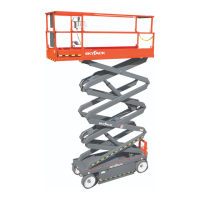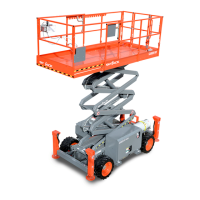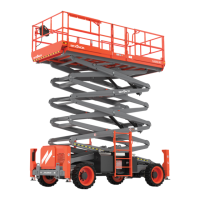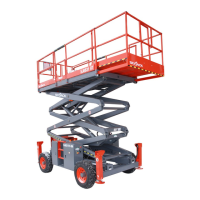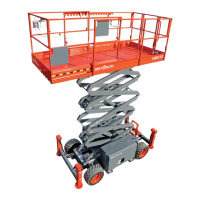83
Section 4 – Troubleshooting Information Electrical System
4.2-6 No Emergency Down Function from Base Control Console*
NOTE
*circuit has redundant wiring and a multiple position (left - spring neutral center - right) Emergency
Lowering toggle switch S51, which will allow function of lowering in either position from neutral center
(see below scenarios
1. Loose or broken wire #98 from Battery to Circuit
Breaker CB2 or the circuit breaker is open.
Check continuity to circuit breaker. Test Circuit
Breaker CB2. Replace if defective.
2. Loose or broken wire #98A from Circuit Breaker
CB2 to Main Disconnect S1.
Check continuity. Replace if defective.
3. Main battery disconnect switch S1 open or
defective.
Close switch. Check continuity. Replace if
defective.
Scenario A:
▪
*Emergency Lowering toggle switch S51 held in “up” position (as per electrical schematic)
▪
Loose or broken wire #98B from Main
Disconnect S1 to Emergency Lowering switch
S51.
Check continuity. Replace if defective.
▪
Loose or broken wire #05 from Circuit Breaker
CB1 to Emergency Lowering switch S51.
Check continuity. Replace if defective.
▪
Open or defective Emergency Lowering switch
S51.
Check continuity between wire #98B and wire
#00D on switch, and
Check continuity between wire #05 and wire #13
on switch.
Replace switch if no continuity on both of these two
(2) contacts of switch.
7. Machine overloaded and Overload Lights PL-1
and PL-2 on Emergency Stop buttons flashing
Check machine limits and reduce weight as
required.
Check Pressure Transducer PT1 and Angle
Transducer AT1 functionality
Check wire #60 from Control Module CM1 pin
#P1-8 (overloaded signal)
Test for 24V Output voltage between wire #60 and
wire #00.
Use HMI Diagnostic menu to make sure Output
P1-8 signal is present (pulsed).
8. External or internal fault detected by Control
Module CM1
Check Control Module display screen. Use
Diagnostic Menu to see switch and sensor status.
Correct trouble code as displayed. Replace module
if defective.
